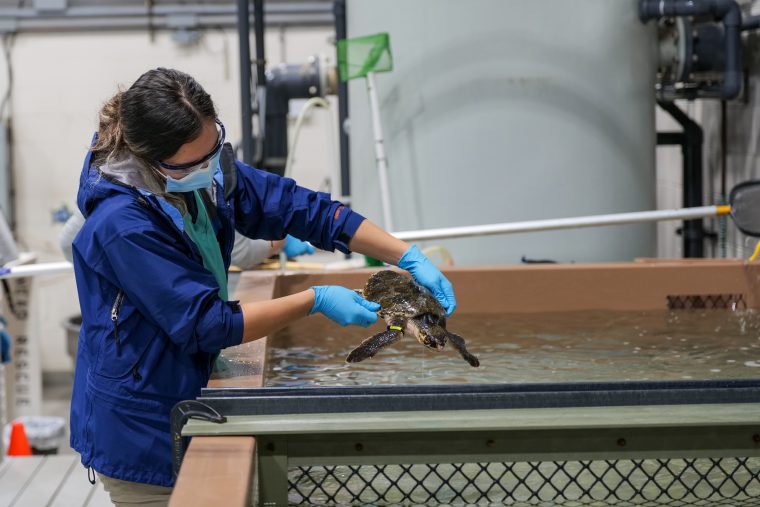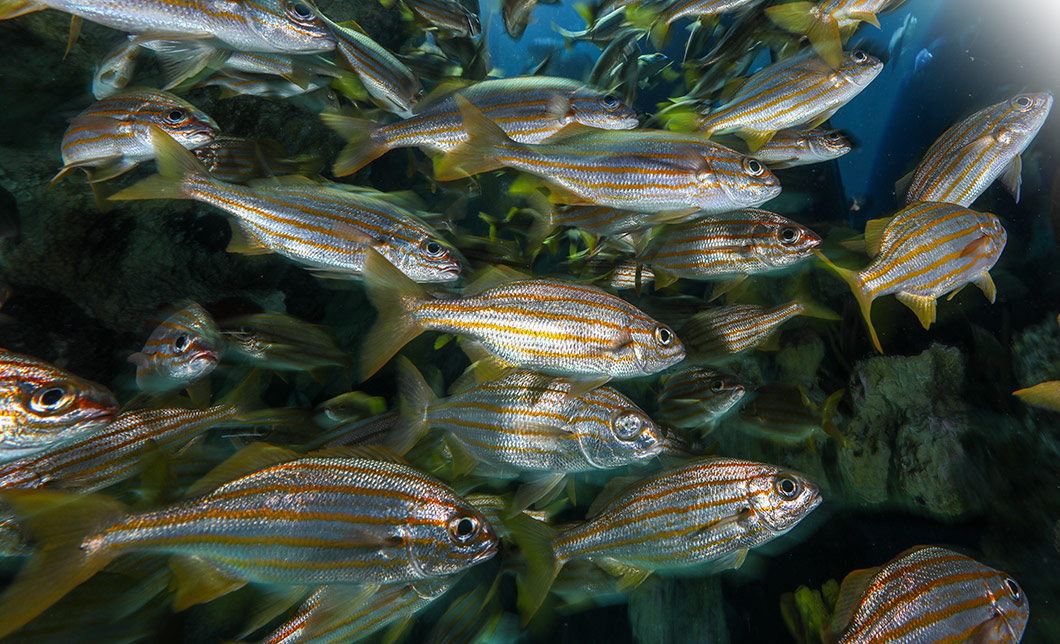We will be closed on Tuesday, April 30, for a day of strategy work and team building.
The New Balance Foundation Marine Mammal Center will be closed for exhibit maintenance on Monday, April 29 and Wednesday, May 1.

QUINCY, MASS. (December 16, 2020) – Cape Cod’s 2020 sea turtle rescue season is setting records both for the number of cold-stunned turtles rescued and recovered on Cape beaches and the volume of turtles now receiving life-saving medical treatment at the New England Aquarium’s Animal Care Center in Quincy and the National Marine Life Center in Buzzards Bay.
*NEW VIDEO AND PHOTOS FROM THE AQUARIUM’S SEA TURTLE HOSPITAL AVAILABLE HERE*
With more than 900 turtles stranding on the Cape since early last month, the New England Aquarium reports that 720 turtles have received veterinary care between the two marine animal rehabilitation facilities—more admissions than in 2014, when an all-time record 692 live turtles were admitted and 1,241 sea turtles rescued. Overall, the current cold-stun season is the second busiest in the 30 years the rescue program has existed.
“We knew this season would present a major challenge with the pandemic requiring additional safety protocols. Combine that with historic stranding numbers, and the rescue and rehab operation has been nothing short of extraordinary,” said Connie Merigo, marine animal rescue department manager at the New England Aquarium. “This year has been all about partnerships. We are grateful to have such a strong network supporting our sea turtle work.”
“The 2020 cold stun season continues to be an extraordinary season for sea turtles and everyone involved in this tremendous rescue, rehab and release effort,” said Lisa Becker, director of marine animal rehabilitation at National Marine Life Center. “We are excited to work alongside the New England Aquarium to give these cold stunned sea turtles stranded in Cape Cod another chance in life and are thankful for our volunteers and everyone who supports us during these record-breaking times.”
Cold-stunning occurs when sea turtles foraging along the New England coast during the summer become trapped in Cape Cod Bay in the fall. As water and air temperatures drop, turtles become hypothermic, eventually stop swimming, and can wash ashore in moderate to strong winds. Volunteers and staff for Mass Audubon’s Wellfleet Bay Wildlife Sanctuary patrol beaches after each high tide, even in the middle of the night, to get stranded turtles off the beach. Turtles are then driven to one of the two marine animal care facilities.
Most of the turtles that strand during the fall are young Kemp’s ridleys, the most critically endangered sea turtles. Juvenile and sub-adult loggerhead sea turtles, a threatened species, are significantly larger than ridleys, and typically strand in mid-December.

Once they reach the Aquarium’s sea turtle hospital, the cold-stunned turtles are medically evaluated and undergo radiographs and X-Rays to look for any fractured bones or signs of pneumonia. Staff biologists give the turtles antibiotics and replacement fluids along with a trial swim to determine their level of activity and alertness. The Aquarium developed a special water temperature protocol during the pandemic to help process the animals more efficiently; the turtles are slowly warmed to normal body temperatures with a 55-degree water temperature for the first 24 hours, then up to 65 degrees for the next 24 hours, before reaching 75 degrees. At least 75% of cold-stunned turtles admitted to the Aquarium will recover to be released back into the wild.
Merigo says critical to managing the huge numbers of sea turtles in Massachusetts has been the overall coordination by the National Oceanic and Atmospheric Administration (NOAA), secondary rehabilitation facilities in other states making room for incoming turtles, and the transport of the animals by plane. Turtles Fly Too, a volunteer general aviation organization, has flown nearly 500 sea turtles from Massachusetts to rehab facilities in Florida, Texas, and other locations over the last six weeks.
“This has been our largest transport year so far,” said Leslie Weinstein, president of Turtles Fly Too. “Our volunteer pilots have flown 13 missions to 32 total facilities throughout the South and Midwest, some that required multiple drops or additional planes to pick up partial cargo loads. The collaboration among all of these partner organizations cannot be understated.”
“The aviation community has really rallied around us,” Merigo added. “We’ve been very fortunate that they’ve stepped up and helped us transport these animals.”
Bob Prescott, who oversees Mass Audubon’s sea turtle rescue program, says while it’s not clear what causes a big stranding year, winds and water temperatures appear to be key factors.
“The Gulf of Maine is warming much faster than the global average, which has allowed turtles to come into the Gulf and Cape Cod Bay, specifically,” he notes. Prescott says east winds associated with passing tropical storms in the summer could push turtles closer to shore from the Gulf Stream. In the fall, frequent, strong west/southwest winds may push turtles into the northeast corner of the bay and prevent them from finding their way around the tip of the Cape before the water cools and slows them down. “This year, just as in 2014, most of our turtles have come ashore in the northeast corner of the bay from Provincetown to Wellfleet,” Prescott said.
Donations are crucial to continuing this conservation work. Those looking to support sea turtle rescue and rehabilitation can visit massaudubon.org, neaq.org, nmlc.org, and turtlesflytoo.org.
MEDIA CONTACT:
Pam Bechtold Snyder – psnyder@neaq.org, 617-686-5068

